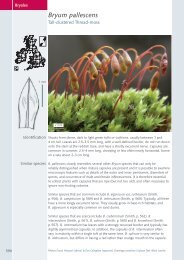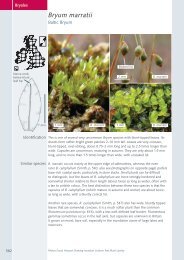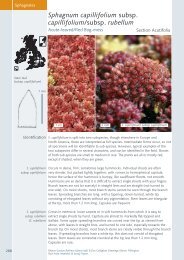Bryum pseudotriquetrum - BBS Field Guide
Bryum pseudotriquetrum - BBS Field Guide
Bryum pseudotriquetrum - BBS Field Guide
You also want an ePaper? Increase the reach of your titles
YUMPU automatically turns print PDFs into web optimized ePapers that Google loves.
592<br />
Bryales<br />
1 mm<br />
Identification<br />
Similar species<br />
<strong>Bryum</strong> <strong>pseudotriquetrum</strong><br />
B. <strong>pseudotriquetrum</strong> var. <strong>pseudotriquetrum</strong><br />
Marsh <strong>Bryum</strong> Key 171<br />
2 mm<br />
The shoots of this relatively large <strong>Bryum</strong> form green to reddish or brown tufts and<br />
patches up to several centimetres tall. The stems are often reddish, and this colouring<br />
may extend onto the leaves, which are equally spaced along the stem, 2–3.5 mm<br />
long, with a border of narrow cells and a thick nerve that is usually only shortly<br />
excurrent. Most plants have leaves with a base that runs down onto the stem, a<br />
feature shared with few other <strong>Bryum</strong> species, and hence important for identification,<br />
although this feature is not always well-developed. The lower part of the stems is<br />
covered with a brown mat of rhizoids. The pendulous, or less often inclined capsules<br />
are brown when mature in summer and autumn. They are quite frequent, large<br />
(3.5 mm long) and borne on a long seta (2–3 cm).<br />
B. <strong>pseudotriquetrum</strong> has male and female organs on separate plants, and is<br />
indistinguishable in the field from B. bimum (Smith, p. 566), which has male and<br />
female organs together in the same inflorescence on one shoot. B. bimum is often<br />
treated as B. <strong>pseudotriquetrum</strong> var. bimum because it is so similar, and grows in<br />
similar habitats. It is less common than B. <strong>pseudotriquetrum</strong> in many districts. Stunted<br />
forms of B. <strong>pseudotriquetrum</strong> may resemble B. pallens (p. 584), but that plant lacks a<br />
red leaf base, tends to have wider leaf cells, and has leaves that do not or only slightly<br />
run down onto the stem.<br />
Red plants differ from B. alpinum (p. 599) in the wider mid-leaf cells, well-developed<br />
leaf border and a leaf base that usually runs down onto the stem, features which can<br />
be seen with a hand lens.<br />
Photos David Holyoak Drawing Jonathan Graham Text Mark Lawley
Habitat<br />
2 mm<br />
Bryales<br />
Bryales<br />
Shoots of the very rare or extinct B. turbinatum (Smith, p. 545) somewhat resemble<br />
those of B. <strong>pseudotriquetrum</strong>, but lack a red leaf base. Also, its mature and empty<br />
capsules are distinctive in being not only wide-mouthed and narrowing markedly just<br />
below the mouth when dry, but also relatively short.<br />
B. schleicheri var. latifolium (Smith, p. 546) is also very rare. It forms yellow-green<br />
tufts up to 10 cm tall, and has broad, concave, acutely tipped leaves. It is currently<br />
known from a single flush on a hill in Stirlingshire.<br />
The leaves of B. pallescens (p. 590) do not run down onto the stem. B. laevifilum<br />
(p. 587) has filamentous gemmae in its leaf axils (as B. <strong>pseudotriquetrum</strong><br />
occasionally does), but B. laevifilum usually grows on bark. B. weigelii (p. 581) also<br />
has a leaf base that runs down onto the stem, but it does so more widely than in<br />
B. <strong>pseudotriquetrum</strong>. Blunt forms of B. <strong>pseudotriquetrum</strong> growing in wet places<br />
might be confused with B. marratii, etc. (p. 582), but in those species the nerve<br />
ceases below the tip.<br />
Non-fruiting plants of Funaria hygrometrica (p. 561), Entosthodon species<br />
(pp. 562–564), Physcomitrium pyriforme (p. 565), Pohlia species (pp. 603–611)<br />
or Aphanorrhegma patens (p. 567) might also conceivably be confused with<br />
B. <strong>pseudotriquetrum</strong>.<br />
B. <strong>pseudotriquetrum</strong> is the commonest British <strong>Bryum</strong> in marshes, fens, and flushes. It<br />
also occurs on damp soil by lakes, in dune slacks, and on wet rocks on cliffs.<br />
593





